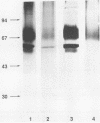Abstract
Pseudohyphae of Candida albicans bear surface receptors for iC3b and C3d. In order to determine a possible role for these receptors in the pathogenesis of candidiasis, a spontaneous C. albicans mutant, m-10, which exhibits reduced ability to adhere in vitro to fibrin platelet clots and epithelial cells or to cause endocarditis in a rabbit model, and its parent wild-type (wt) strain were compared for receptor expression in rosetting assays with sheep erythrocytes carrying iC3b (EAC1423bi) or C3d (EAC1423d). An equally high attachment to wt and m-10 was seen with EAC1423d, whereas rosetting with EAC1423bi was reduced by 53% in m-10 compared with wt. In inhibition studies, rosetting of wt with EAC1423bi was markedly inhibited by culture filtrate, hyphal-cell extract, and DEAE-fractionated material prepared from wt (54, 87, and 70% decreases in rosetting, respectively), thus suggesting the presence of the soluble, functionally active iC3b receptor of C. albicans in each of these preparations. Minimal inhibition of iC3b rosetting, however, was seen with the identical materials from m-10 (21, 5, and 12%, respectively). All of the preparations from the two strains were equally effective in their inhibitory activities against rosetting of C3d. A human serum specimen obtained from a patient with chronic mucocutaneous candidiasis blocked iC3b rosetting of the wt strain almost completely. When used in an immunoblot, this serum recognized proteins of 68 to 71, 55, and 50 kilodaltons (kDa) in hyphal-cell extracts of the wt. With the same preparation of the avirulent mutant, only weak reactions with the 68- to 71-kDa and 55-kDa proteins occurred, while the 50-kDa protein was not detectable. Taken together, these results indicate that the expression of the functionally active iC3b receptor on C. albicans may be involved in the virulence of the organism, possibly by mediating adherence to mammalian cells.
Full text
PDF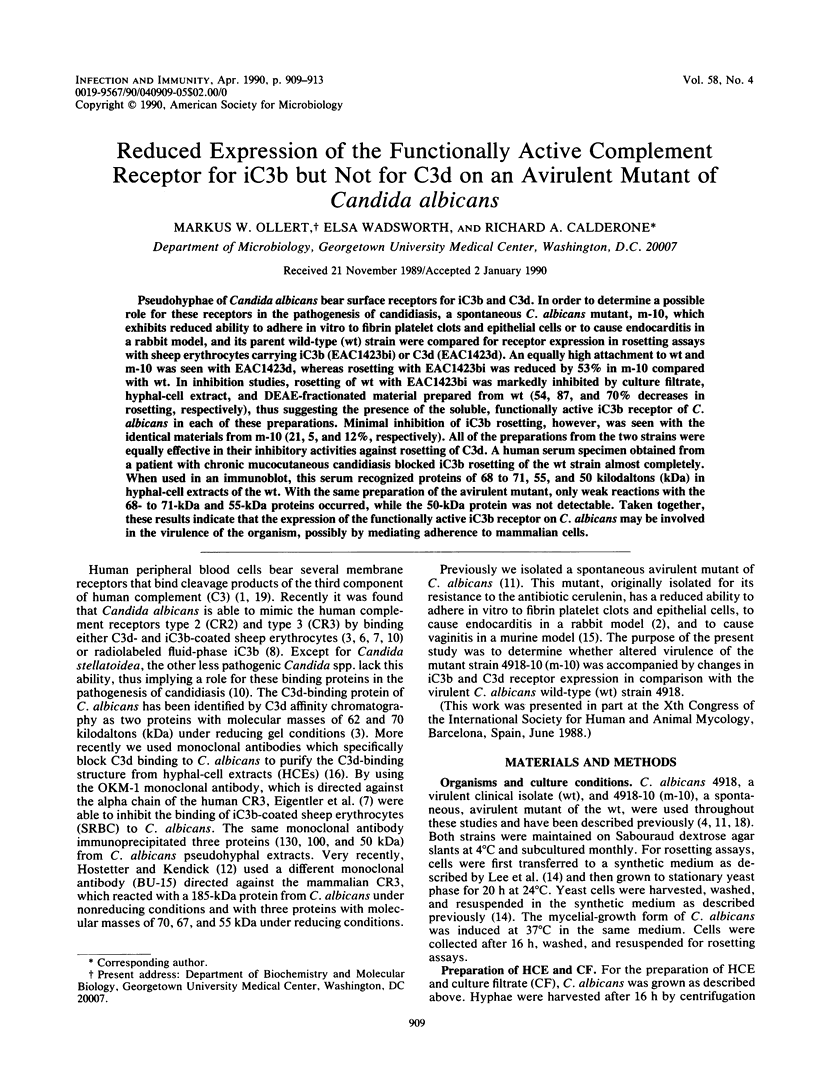
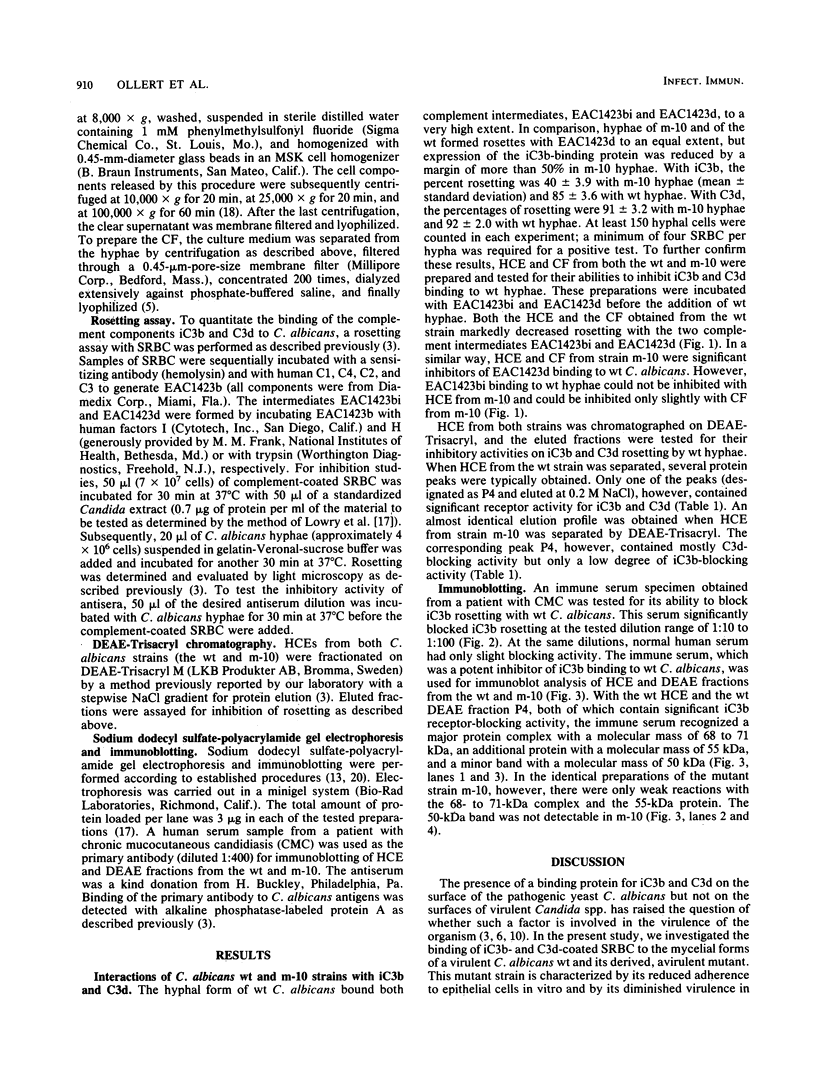
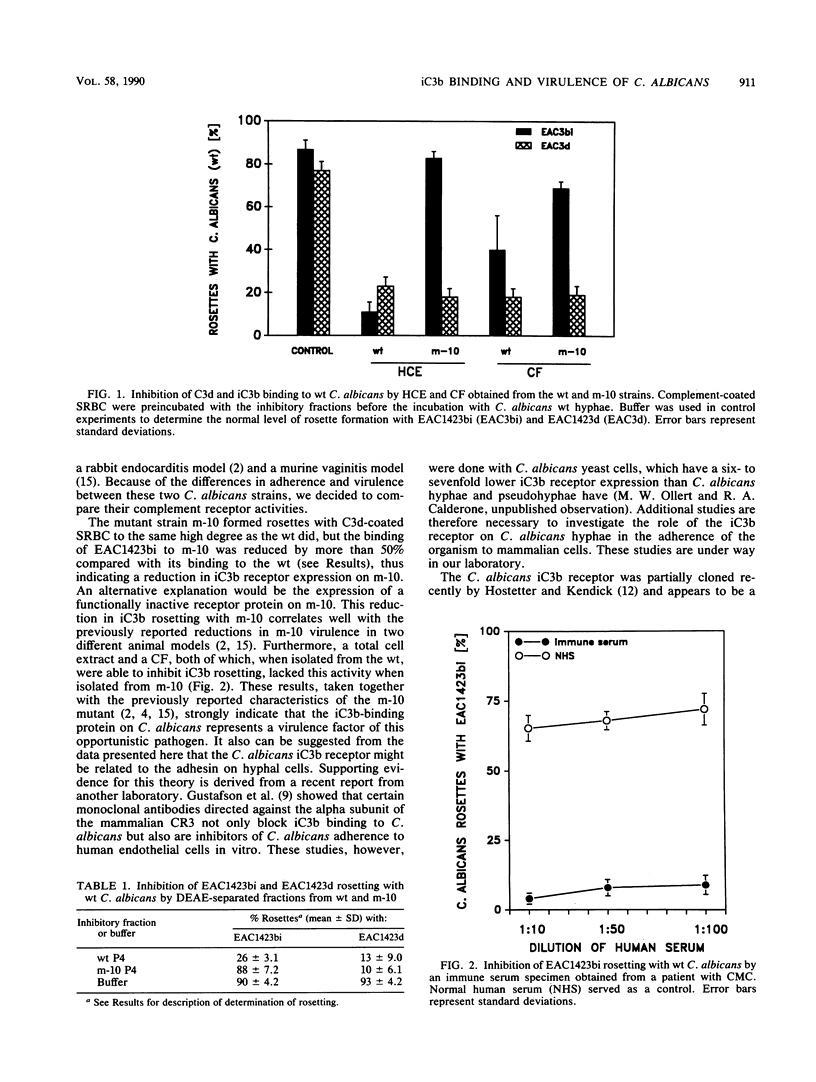
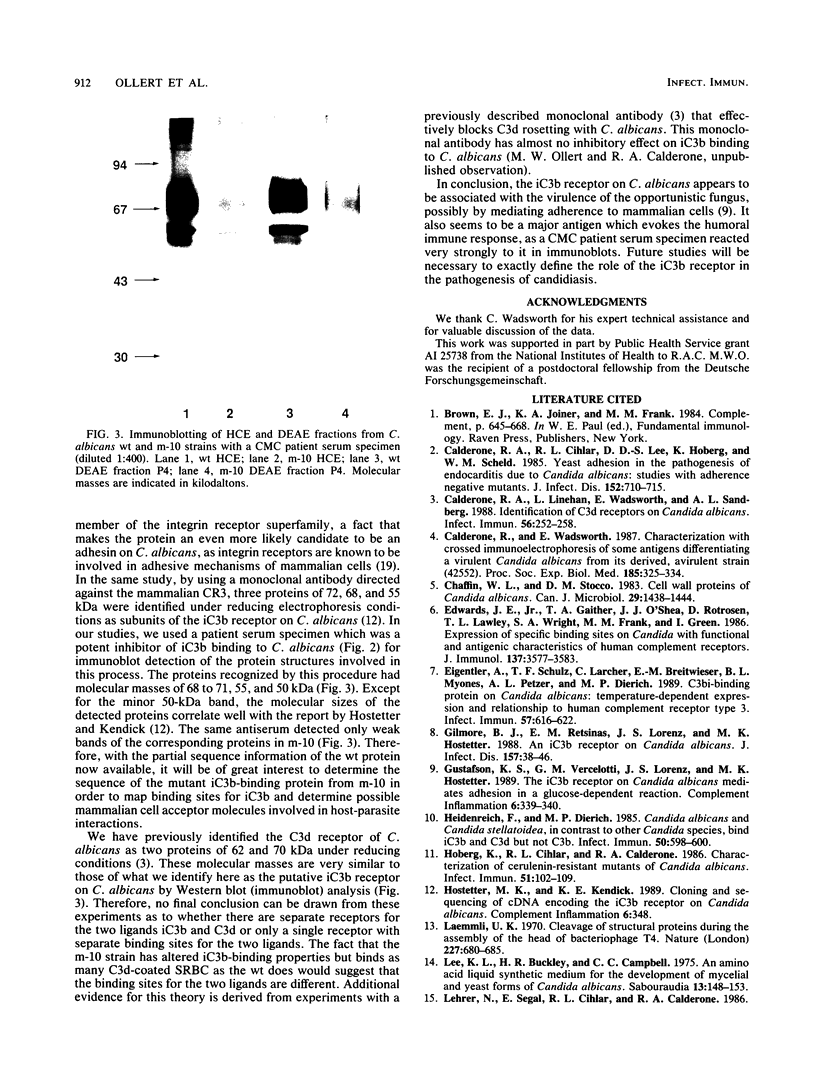
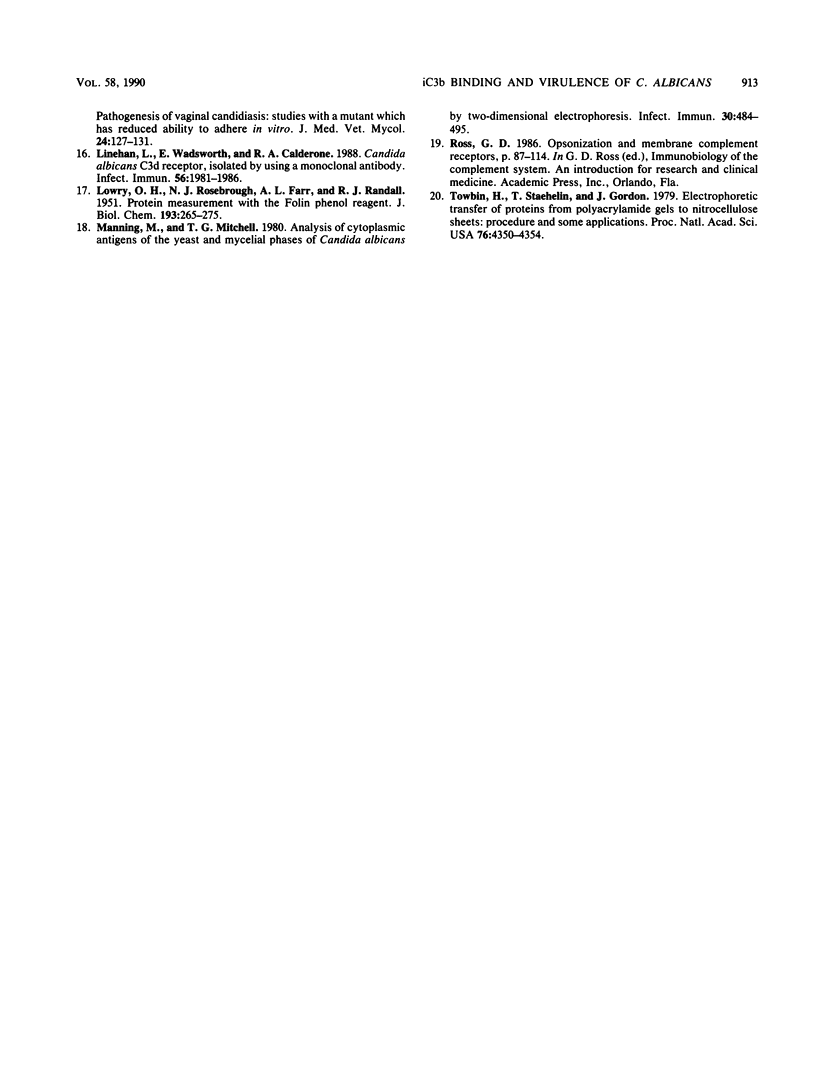
Images in this article
Selected References
These references are in PubMed. This may not be the complete list of references from this article.
- Calderone R. A., Cihlar R. L., Lee D. D., Hoberg K., Scheld W. M. Yeast adhesion in the pathogenesis of endocarditis due to Candida albicans: studies with adherence-negative mutants. J Infect Dis. 1985 Oct;152(4):710–715. doi: 10.1093/infdis/152.4.710. [DOI] [PubMed] [Google Scholar]
- Calderone R. A., Linehan L., Wadsworth E., Sandberg A. L. Identification of C3d receptors on Candida albicans. Infect Immun. 1988 Jan;56(1):252–258. doi: 10.1128/iai.56.1.252-258.1988. [DOI] [PMC free article] [PubMed] [Google Scholar]
- Calderone R., Wadsworth E. Characterization with crossed immunoelectrophoresis of some antigens differentiating a virulent Candida albicans from its derived, avirulent strain. Proc Soc Exp Biol Med. 1987 Jul;185(3):325–334. doi: 10.3181/00379727-185-42552. [DOI] [PubMed] [Google Scholar]
- Chaffin W. L., Stocco D. M. Cell wall proteins of Candida albicans. Can J Microbiol. 1983 Oct;29(10):1438–1444. doi: 10.1139/m83-220. [DOI] [PubMed] [Google Scholar]
- Edwards J. E., Jr, Gaither T. A., O'Shea J. J., Rotrosen D., Lawley T. J., Wright S. A., Frank M. M., Green I. Expression of specific binding sites on Candida with functional and antigenic characteristics of human complement receptors. J Immunol. 1986 Dec 1;137(11):3577–3583. [PubMed] [Google Scholar]
- Eigentler A., Schulz T. F., Larcher C., Breitwieser E. M., Myones B. L., Petzer A. L., Dierich M. P. C3bi-binding protein on Candida albicans: temperature-dependent expression and relationship to human complement receptor type 3. Infect Immun. 1989 Feb;57(2):616–622. doi: 10.1128/iai.57.2.616-622.1989. [DOI] [PMC free article] [PubMed] [Google Scholar]
- Gilmore B. J., Retsinas E. M., Lorenz J. S., Hostetter M. K. An iC3b receptor on Candida albicans: structure, function, and correlates for pathogenicity. J Infect Dis. 1988 Jan;157(1):38–46. doi: 10.1093/infdis/157.1.38. [DOI] [PubMed] [Google Scholar]
- Heidenreich F., Dierich M. P. Candida albicans and Candida stellatoidea, in contrast to other Candida species, bind iC3b and C3d but not C3b. Infect Immun. 1985 Nov;50(2):598–600. doi: 10.1128/iai.50.2.598-600.1985. [DOI] [PMC free article] [PubMed] [Google Scholar]
- Hoberg K. A., Cihlar R. L., Calderone R. A. Characterization of cerulenin-resistant mutants of Candida albicans. Infect Immun. 1986 Jan;51(1):102–109. doi: 10.1128/iai.51.1.102-109.1986. [DOI] [PMC free article] [PubMed] [Google Scholar]
- LOWRY O. H., ROSEBROUGH N. J., FARR A. L., RANDALL R. J. Protein measurement with the Folin phenol reagent. J Biol Chem. 1951 Nov;193(1):265–275. [PubMed] [Google Scholar]
- Laemmli U. K. Cleavage of structural proteins during the assembly of the head of bacteriophage T4. Nature. 1970 Aug 15;227(5259):680–685. doi: 10.1038/227680a0. [DOI] [PubMed] [Google Scholar]
- Lee K. L., Buckley H. R., Campbell C. C. An amino acid liquid synthetic medium for the development of mycelial and yeast forms of Candida Albicans. Sabouraudia. 1975 Jul;13(2):148–153. doi: 10.1080/00362177585190271. [DOI] [PubMed] [Google Scholar]
- Lehrer N., Segal E., Cihlar R. L., Calderone R. A. Pathogenesis of vaginal candidiasis: studies with a mutant which has reduced ability to adhere in vitro. J Med Vet Mycol. 1986 Apr;24(2):127–131. doi: 10.1080/02681218680000191. [DOI] [PubMed] [Google Scholar]
- Linehan L., Wadsworth E., Calderone R. Candida albicans C3d receptor, isolated by using a monoclonal antibody. Infect Immun. 1988 Aug;56(8):1981–1986. doi: 10.1128/iai.56.8.1981-1986.1988. [DOI] [PMC free article] [PubMed] [Google Scholar]
- Manning M., Mitchell T. G. Analysis of cytoplasmic antigens of the yeast and mycelial phases of Candida albicans by two-dimensional electrophoresis. Infect Immun. 1980 Nov;30(2):484–495. doi: 10.1128/iai.30.2.484-495.1980. [DOI] [PMC free article] [PubMed] [Google Scholar]
- Towbin H., Staehelin T., Gordon J. Electrophoretic transfer of proteins from polyacrylamide gels to nitrocellulose sheets: procedure and some applications. Proc Natl Acad Sci U S A. 1979 Sep;76(9):4350–4354. doi: 10.1073/pnas.76.9.4350. [DOI] [PMC free article] [PubMed] [Google Scholar]



